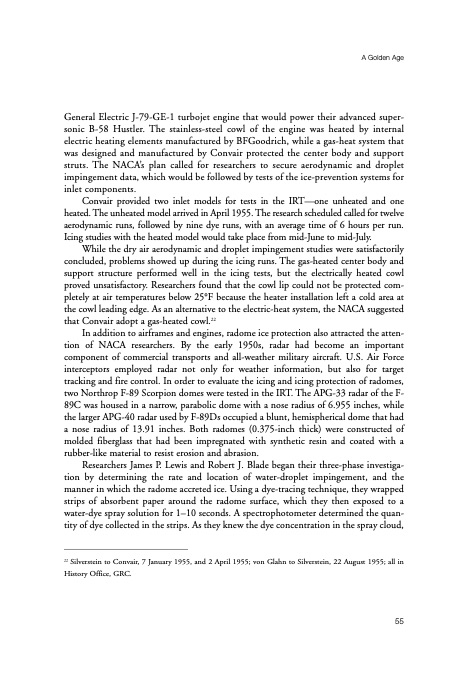
PDF Publication Title:
Text from PDF Page: 068
General Electric J-79-GE-1 turbojet engine that would power their advanced super- sonic B-58 Hustler. The stainless-steel cowl of the engine was heated by internal electric heating elements manufactured by BFGoodrich, while a gas-heat system that was designed and manufactured by Convair protected the center body and support struts. The NACA’s plan called for researchers to secure aerodynamic and droplet impingement data, which would be followed by tests of the ice-prevention systems for inlet components. Convair provided two inlet models for tests in the IRT—one unheated and one heated. The unheated model arrived in April 1955. The research scheduled called for twelve aerodynamic runs, followed by nine dye runs, with an average time of 6 hours per run. Icing studies with the heated model would take place from mid-June to mid-July. While the dry air aerodynamic and droplet impingement studies were satisfactorily concluded, problems showed up during the icing runs. The gas-heated center body and support structure performed well in the icing tests, but the electrically heated cowl proved unsatisfactory. Researchers found that the cowl lip could not be protected com- pletely at air temperatures below 25°F because the heater installation left a cold area at the cowl leading edge. As an alternative to the electric-heat system, the NACA suggested that Convair adopt a gas-heated cowl.22 In addition to airframes and engines, radome ice protection also attracted the atten- tion of NACA researchers. By the early 1950s, radar had become an important component of commercial transports and all-weather military aircraft. U.S. Air Force interceptors employed radar not only for weather information, but also for target tracking and fire control. In order to evaluate the icing and icing protection of radomes, two Northrop F-89 Scorpion domes were tested in the IRT. The APG-33 radar of the F- 89C was housed in a narrow, parabolic dome with a nose radius of 6.955 inches, while the larger APG-40 radar used by F-89Ds occupied a blunt, hemispherical dome that had a nose radius of 13.91 inches. Both radomes (0.375-inch thick) were constructed of molded fiberglass that had been impregnated with synthetic resin and coated with a rubber-like material to resist erosion and abrasion. Researchers James P. Lewis and Robert J. Blade began their three-phase investiga- tion by determining the rate and location of water-droplet impingement, and the manner in which the radome accreted ice. Using a dye-tracing technique, they wrapped strips of absorbent paper around the radome surface, which they then exposed to a water-dye spray solution for 1–10 seconds. A spectrophotometer determined the quan- tity of dye collected in the strips. As they knew the dye concentration in the spray cloud, A Golden Age 22 Silverstein to Convair, 7 January 1955, and 2 April 1955; von Glahn to Silverstein, 22 August 1955; all in History Office, GRC. 55PDF Image | History of NASA Icing Research Tunnel

PDF Search Title:
History of NASA Icing Research TunnelOriginal File Name Searched:
sp4226.pdfDIY PDF Search: Google It | Yahoo | Bing
NFT (Non Fungible Token): Buy our tech, design, development or system NFT and become part of our tech NFT network... More Info
IT XR Project Redstone NFT Available for Sale: NFT for high tech turbine design with one part 3D printed counter-rotating energy turbine. Be part of the future with this NFT. Can be bought and sold but only one design NFT exists. Royalties go to the developer (Infinity) to keep enhancing design and applications... More Info
Infinity Turbine IT XR Project Redstone Design: NFT for sale... NFT for high tech turbine design with one part 3D printed counter-rotating energy turbine. Includes all rights to this turbine design, including license for Fluid Handling Block I and II for the turbine assembly and housing. The NFT includes the blueprints (cad/cam), revenue streams, and all future development of the IT XR Project Redstone... More Info
Infinity Turbine ROT Radial Outflow Turbine 24 Design and Worldwide Rights: NFT for sale... NFT for the ROT 24 energy turbine. Be part of the future with this NFT. This design can be bought and sold but only one design NFT exists. You may manufacture the unit, or get the revenues from its sale from Infinity Turbine. Royalties go to the developer (Infinity) to keep enhancing design and applications... More Info
Infinity Supercritical CO2 10 Liter Extractor Design and Worldwide Rights: The Infinity Supercritical 10L CO2 extractor is for botanical oil extraction, which is rich in terpenes and can produce shelf ready full spectrum oil. With over 5 years of development, this industry leader mature extractor machine has been sold since 2015 and is part of many profitable businesses. The process can also be used for electrowinning, e-waste recycling, and lithium battery recycling, gold mining electronic wastes, precious metals. CO2 can also be used in a reverse fuel cell with nafion to make a gas-to-liquids fuel, such as methanol, ethanol and butanol or ethylene. Supercritical CO2 has also been used for treating nafion to make it more effective catalyst. This NFT is for the purchase of worldwide rights which includes the design. More Info
NFT (Non Fungible Token): Buy our tech, design, development or system NFT and become part of our tech NFT network... More Info
Infinity Turbine Products: Special for this month, any plans are $10,000 for complete Cad/Cam blueprints. License is for one build. Try before you buy a production license. May pay by Bitcoin or other Crypto. Products Page... More Info
| CONTACT TEL: 608-238-6001 Email: greg@infinityturbine.com | RSS | AMP |